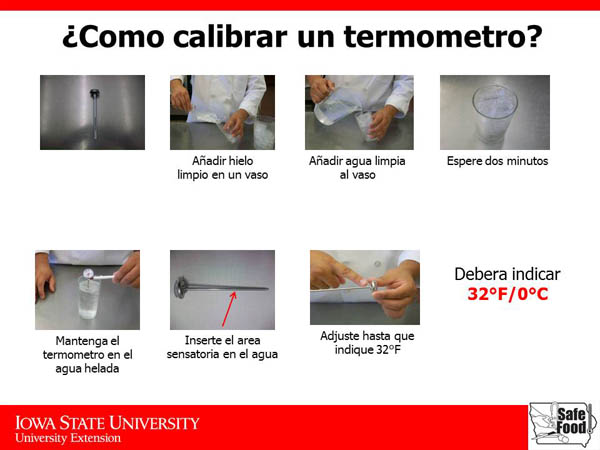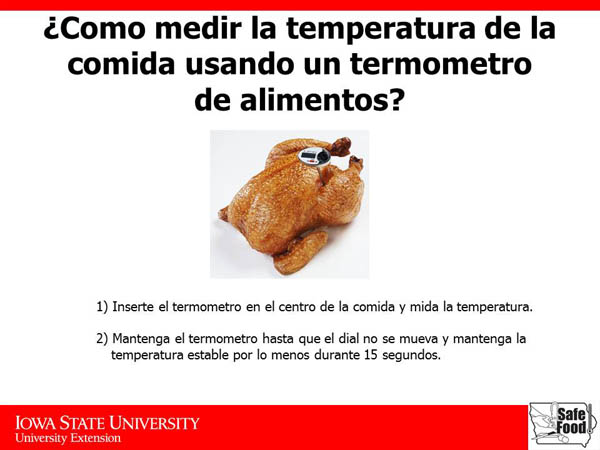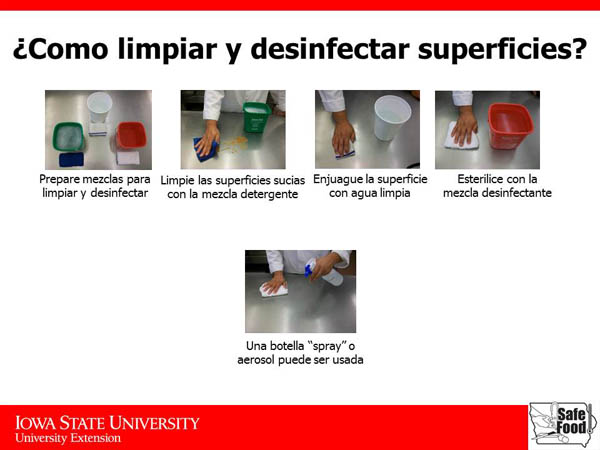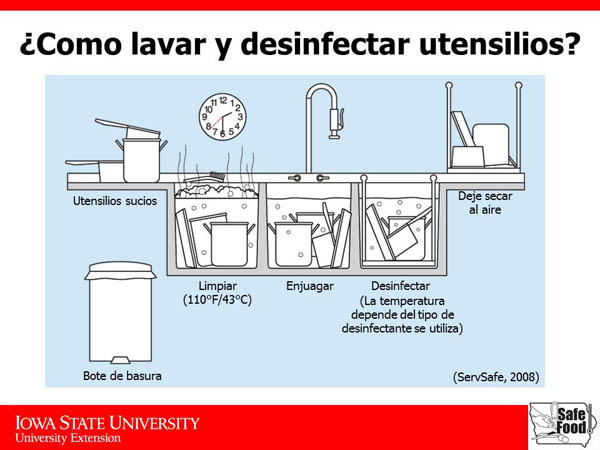 |
April 2013
|
April 2013 // Volume 51 // Number 2 // Feature // v51-2a8
Educating Immigrant Hispanic Foodservice Workers About Food Safety Using Visual-Based Training
Abstract
Providing food safety training to a diverse workforce brings with it opportunities and challenges that must be addressed. The study reported here provides evidence for benefits of using visual-based tools for food safety training when educating immigrant, Hispanic foodservice workers with no or minimal English language skills. Using visual tools along with hands-on training improved knowledge scores of foodservice workers about thermometer use and cleaning and sanitizing procedures. Extension personnel can use similar educational tools along with accommodation for cultural differences for effective training of immigrant Hispanic workers employed in foodservice and lodging operations, farms, and meat processing plants.
Introduction
Preventing incidents of foodborne illness is important to all retail foodservice establishments. Vugia et al (2008) found that 59% of the foodborne illnesses originate from retail foodservice establishments. Foodborne illness from known disease-causing agents in food leads to an estimated 9.4 million illnesses, 55,961 hospitalizations, and 1,351 deaths in the United States annually (Scallan et al., 2011b). In addition, unknown disease-causing agents result in 38.4 million illnesses, 71,878 hospitalizations, and 1,686 deaths (Scallan, Griffin, Angulo, Tauxe, & Hoekstra, 2011a). According to the World Health Organization (WHO), most foodborne illnesses result from improper food handling practices (improper cooking procedures, temperature abuse during storage, lack of hygiene and sanitation by food handlers, cross-contamination between raw and fresh ready-to-eat foods, and acquiring food from unsafe sources) by food handlers in retail foodservice establishments (WHO, 2006). Among the top causes of foodborne illness identified by WHO, five directly relate to food handler behavior. Therefore, it is imperative to control for these behaviors in all types of foodservice establishments—ethnic and non-ethnic.
Among ethnic restaurants, Asian and Mexican restaurants are the most popular cuisines in the United States (Simonne, Nille, Evans, & Marshall, 2004). With the increasing diversity of the workforce and increase in the number of ethnic restaurants, evaluation of food handling practices among ethnic food handlers is essential to maintain uniformity in food safety practices in all foodservice establishments. Studies have found that among retail foodservice establishments, food handling practices at ethnic restaurants were not in accordance with 2005 Food Code requirements (Mauer et al., 2006; Roberts, Kwon, Shanklin, Liu, & Yen, 2011).
The reasons for this difference could range from lack of knowledge, lack of risk perception, and/or lack of resources to practice food safety (unavailability of thermometers, poor managerial control, or poor access to handwashing sinks). Language barriers are a major impediment towards understanding and practicing food safety (Bermúdez-Millán, Pérez-Escamilla, Damio, Gonźalez, & Segura- Pérez, 2004; Rudder, 2006). In a study conducted by Niode, Bruhn, and Simonne (2010), Hispanic and Asian restaurant managers indicated that their foodservice staff did not always follow food safety practices and the managers did not feel that non-compliance with food safety guidelines would lead to consequences. These issues highlight the need to address food safety practices in ethnic restaurants.
The Hispanic population in the United States is growing and constitutes 15% of the total population (U.S. Census Bureau, 2011). Around 21% of immigrant Hispanics in the United States are employed in foodservice and service-related occupations. According to the Iowa Data Center (2011), the Hispanic population comprises 5% of the total population in Iowa, of which 36.8 % are foreign-born. The Hispanic population in Iowa increased by 83.7% between 2000 and 2010. It is expected that by 2040, Hispanics will make up 11.9% of Iowa's population. Hispanic-owned business increased by 159.8% from 2002 to 2009. This demographic has culturally unique needs that can be challenging to address (Farner, Rhoads, Cutz, & Farner, 2005). The needs of this unique demographic can be addressed by using simple and easy-to-use tools. One method that can be used to train non-English speaking Hispanic foodservice workers about food safety is by using minimal-text visuals in Spanish.
Purpose and Objectives
The purpose of the study reported here was to educate Hispanic foodservice workers who had minimal or no English language skills about safe food handling practices as prescribed by the 2005 Food Code (U.S. Food and Drug Administration, 2005). The 2005 Food Code was being used by foodservice establishments in Iowa during the period of the research study. The study focused on educating Hispanic foodservice workers about proper thermometer use and cleaning and sanitizing procedures using visuals, while the first phase of the study focused on proper handwashing and glove use (Rajagopal, 2012).
According to the Food and Drug Administration, poor personal hygiene, cross contamination, and time-temperature abuse are the three main reasons for foodborne illness in the United States (FDA, 2009). By educating foodservice workers about proper handwashing, glove use, thermometer use, and cleaning and sanitizing procedures it is expected that food handling behaviors will improve due to improved knowledge and result in safe food handling practices thus reducing the incidence of foodborne illness.
The specific objectives of the study were to:
- Develop a minimal-text food safety training module using visuals as the key training method to train foodservice workers about thermometer use and cleaning and sanitizing procedures during food handling.
- Assess effectiveness of training on food safety knowledge of foodservice workers.
Methods
Participants were recruited with assistance from the Iowa State University Extension offices throughout Iowa. Participants were immigrant, Hispanic foodservice workers who spoke little or no English. Participants were recruited by word of mouth by the Spanish-speaking Extension personnel, as it was found to be the most reliable method of reaching the Hispanic population. Previous research has shown that using a community contact person whom the participants trust to be a reliable method of reaching Hispanic audiences (Boone, Penner, Johnson, Young, & Lubbers, 2004; Escobar-Chaves, Tortolero, Masse, Watson, & Fulton, 2002; Fidalgo & Chapman-Novakofski, 2001).
All participants received a $10 gift card for groceries, a food thermometer, chlorine sanitizer strips, and handouts of training materials (Figure 1) as incentives for participation. The research protocol was reviewed and approved by the university's Institutional Review Board for Human Subjects prior to data collection. All participants provided informed consent prior to participation in the study.
Figure 1.
Handouts of Training Materials









Food safety training materials containing visuals with minimal-text messages about proper thermometer use and cleaning and sanitizing procedures were first developed in English. The materials were then reviewed by a food safety expert and an expert in foodservice operations and then translated into Spanish by a Spanish-speaking Community Extension specialist. The accuracy of translation was verified by another Spanish-speaking individual with experience in food safety training and foodservice operations.
Trainings were conducted in English with assistance from the Community Extension specialist, who then verbally translated the information in Spanish. The translator was not a food safety expert, but had worked closely with other Extension educators in Iowa in conducting training sessions in Spanish on a wide variety of topics.
Six 1-hour training sessions were conducted in Spanish at Iowa State University Extension offices or on-site (at restaurants). Participants were encouraged to ask questions or share their experiences about thermometer use and cleaning and sanitizing at any time during the training session. Training sessions consisted of the following:
- Introduction to the workshop and completion of the informed consent form and pre-training questionnaire.
- Overview of foodborne illness and 2005 Food Code guidelines for safe food handling.
- Introduction to importance of using a food thermometer, thermometer calibration methods, and proper procedure for measuring temperature of foods.
- Hands-on thermometer calibration exercise.
- Introduction to proper cleaning and sanitizing procedures.
- Demonstration of the correct procedure of preparing sanitizer solutions and using sanitizer pH strips.
- Completion of post-training questionnaire.
A questionnaire containing questions along with visuals about key concepts discussed during the training was administered before and after training (Figure 2). Rajagopal (2012) had successfully used a similar visual-based questionnaire to assess food safety knowledge of immigrant Hispanic foodservice workers. The questionnaire was validated by two food safety experts and a Spanish-speaking Extension educator. The questions were also read aloud by the Spanish translator to assist those participants who could not read Spanish. Descriptive statistics and t-tests were conducted using SPSS 20.0 software.
Figure 2.
Questionnaire Containing Visuals used for Assessment of Knowledge

Results
Immigrant, Hispanic foodservice workers (n=49) employed at Hispanic-owned foodservice establishments that served Latin or South American food participated in the study (Table 1). More than 80% of the participants were female, and the remaining were male (16.0%). Most of the participants were between the ages of 21-50 years. Participants had worked in the foodservice industry for less than 1 year (30.0%) to more than 12 years (9.0%). Most participants (60.0%) were involved in back of house duties (handling and preparing food), some participants (19.0%) were involved in front of-house duties (servers, beverage servers, bar managers), while others (21.0%) were responsible for handling both front and back of house duties, a common occurrence in small-size foodservice establishments.
| Demographic Characteristics | n (%) |
| Gender | |
| Male | 8(16) |
| Female | 41(84) |
| Age | |
| Less than 21 years | 4 (8.0) |
| 21-30 years | 16 (33.0) |
| 31-40 years | 16 (33.0) |
| 41-50 years | 8 (16.0) |
| 51-60 years | 4 (8.0) | More than 60 years | 1 (2.0) |
| Number of Years Employed in Foodservice | |
| Less than 1 year | 14 (30.0) |
| 1-3 years | 12 (26.0) |
| 4-6 years | 9 (19.0) |
| 7- 10 years | 4 (9.0) |
| 10-12 years | 4 (9.0) |
| More than 12 years | 4 (9.0) |
| Major Duties in the Workplace | |
| Front of the house | 9 (19.0) |
| Back of the house | 29 (60.0) |
| Both (FOH + BOH) | 11 (21.0) |
Before educating participants about thermometer use, participants were asked if they owned a food thermometer, and fit was found that most participants (n=43) did not own a food thermometer. Most of the participants (n=48) had never calibrated a thermometer because they did not know how to calibrate a thermometer or were unaware that a food thermometer should be calibrated. Most participants (n=42) were unaware that proper cleaning and sanitizing procedures is a three-step process (Wash-Rinse-Sanitize). Participant knowledge about thermometer use and cleaning and sanitizing procedures before after training are shown in Table 2. Participant knowledge improved on all questions improved training.
| Questions |
Before Training n (%)
|
After Training n (%)
|
|
¿Es esta una manera aceptable de limpiar y esterilizar la mesa? (It is acceptable to apply sanitizer and detergent solutions using a spray bottle?) |
Yes: 32 (65.0%) No: 12 (26.0%) Don't know: 5 (10.0%) |
Yes: 42 (86.0%) No: 6 (12.0%) Don't know: 1 (2.0%) |
|
La receta de esterilizar basada en lejía para esterilizar superficies o utensilios es de 1 cucharada por cada galón de agua tibia. (The recipe for preparing sanitizer solution is one tablespoon of chlorine to one gallon of warm water) |
Yes: 32 (65.0%) No: 6 (12.0%) Don't know: 11 (22.0%) |
Yes: 46 (94.0%) No: 3 (6.0%) Don't know: 0 (0%) |
|
Limpiar, enjuagar y esterilizar son los tres pasos para una limpieza y esterilización eficaz de utensilios y superficies. (Wash, Rinse, and Sanitize are the three steps that should be used for cleaning and sanitizing utensils and surfaces) |
Yes: 39 (81.0%) No: 3 (6.0%) Don't know: 6 (13.0%) |
Yes: 49 (100.0%) No: 0 (0%) Don't know: 0 (0%) |
|
¿Es sumergir el termómetro en agua helada una manera aceptable de calibrar un termómetro alimenticio? (It is acceptable to use the ice-point method for calibrating a food thermometer) |
Yes: 18 (37.0%) No: 11 (22.0%) Don't know: 20 (41.0%) |
Yes: 49 (100%) No: 0 (0%) Don't know: 0(0%) |
|
¿Debería usted siempre usar un termómetro para medir la temperatura de la comida? (You must insert the food thermometer in the center of the food to accurately measure the temperature) |
Yes: 36 (75.0%) No: 5 (8.0%) Don't know: 8 (17.0%) |
Yes: 49 (100%) No: 0 (0%) Don't know: 0 (0%) |
|
(Responses highlighted in bold are correct responses) |
||
T-test for pre-test and post-test scores showed statistically significant differences for all knowledge questions (Table 3).
| Question | Mean | SD | t-statistic | df | p-value |
| Q1 Pre - Q1 Post | .286 | .736 | 2.717 | 48 | .009* |
| Q2 Pre - Q2 Post | .510 | .845 | 4.228 | 48 | .000* |
| Q3 Pre - Q3 Post | .313 | .689 | 3.142 | 47 | .003* |
| Q4 Pre - Q4 Post | 1.041 | .889 | 8.197 | 48 | .000* |
| Q5 Pre - Q5Post | .404 | .771 | 3.596 | 46 | .001* |
|
*p<0.05, n=49 |
|||||
Discussion, Implications, Conclusions
The study reported here showed that knowledge about thermometer use and cleaning and sanitizing procedures that were lacking among foodservice workers improved significantly after receiving the visual-based training. Nearly 85% of the participants did not own a food thermometer and did not know that food thermometers need to be calibrated prior to use. This result is a major concern because improper time and temperature control of food has been identified as the highest risk factor in retail foodservice establishments contributing to microbial growth on food (FDA, 2009). Extension educators should ensure that their audiences are knowledgeable about the risks associated with time and temperature abuse of food and improper cleaning and sanitizing procedures.
While communicating risks is important, it is also critical to assess if certain behaviors are not being followed due to lack of knowledge, lack of resources, or lack of risk perception. In the study, more than 85% of participants had never owned a food thermometer and had never calibrated a thermometer or were unaware that thermometers should be calibrated. After training, participants were given a food thermometer and a refrigerator thermometer that they could use to prevent time-temperature abuse of food. In addition, hands-on training about thermometer calibration, cleaning and sanitizing of thermometers, and proper procedures for cleaning and sanitizing of utensils and surfaces were demonstrated.
Results from the study provided evidence of the usefulness of visual-based training for educating foodservice workers whose native language is not English. Focus groups conducted by Justen, Haynes, VanDerZanden, and Grudens-Schuck (2011) also found that visual-based tools were highly desired by Latinos employed in the Iowa Horticulture industry. While learning to read, write, and speak English would play a significant role in generating a better understanding about food safety among Spanish-speaking workers, the need for quicker learning of food safety messages can be addressed by conducting training using Spanish language signage, PowerPoint™, along with various hands-on activities (Opatik & Novak, 2010). Receiving training in their native language makes participants feel comfortable and less threatened by the learning environment, which aids in the learning process (Rudder, 2006). While providing training is critical to convey food safety information, it is also critical that training is provided regularly and reflects latest federal, state, and local guidelines.
The role of understanding culture when conducting training and education sessions with immigrant, Spanish-speaking workers is important (Ortiz & Plunkett, 2003). Training and education programs should go beyond tailoring material to a particular audience, building community relationships, and eliminating barriers and move towards applying cultural sensitivity (Uttal, 2006). In the study reported here, participants attended training sessions with their children and other family members whom they could not leave unattended at home. Understanding and accommodating for the collectivistic nature of the Hispanic community demonstrates cultural sensitivity and helps engage and retain participants (Bairstow, Berry, & Driscoll, 2002; Farner, Rhoads, Cutz, & Farner, 2005; Warrix & Bocanegra, 1998).
Recruitment efforts were more successful during this phase of the project because participants had previously participated in the first phase of the study (Rajagopal, 2012). The Extension specialist employed with Iowa State University Extension played a valuable role in recruiting participants and served as a person whom the Spanish-speaking community trusted. Members of the Hispanic community are willing to participate in educational and community development programs if they are familiar with the educators/training providers (Escobar-Chaves et al, 2002; Fidalgo & Chapman-Novakofski, 2001). Extension educators can increase participation in Extension programs by earning the trust of their participants through culturally sensitive behavior and empathetic approach.
Overall, the study was successful in training Spanish-speaking foodservice workers about safe food handling practices using visuals. Conducting training using lecture, hands-on activities, and accommodating for cultural differences helped in reaching out to the Hispanic audiences. Similar visuals can be developed and used for training individuals who speak a wide variety of languages and are employed in a variety of industries such as foodservice, lodging, agriculture, construction, and food processing plants. It will be helpful to seek participant input when developing educational tools, using approaches such as focus groups and unstructured interviews so that the tools are user friendly and meet the needs of learners. Empowering the participants by seeking their input will also help develop tools that are learner centered, making them effective and efficient tools for use in training and education.
All training materials are available on the Iowa State University Extension website at www.iowafoodsafety.org. This website provides a wide variety of food safety materials in English and Spanish for commercial and non-commercial foodservice operations that are available free of charge. Materials include online training modules, printable training materials, in-class activity sheets, and SOPs (Standard Operating Procedures) templates that can be adapted into any foodservice establishment.
Acknowledgments
Funding for this project came from the Heddleson grant provided by the Iowa State University College of Human Sciences. The purpose of Heddleson grants is to provide teaching faculty with the opportunity to learn more about Extension service. Contributions of Barb Anderson and Himar Hernandez-Santana with recruitment and facilitation with this project are highly appreciated. The author would also like to thank Dr. Catherine Strohbehn for her guidance.
References
Bairstow, R., Berry, H., & Driscoll, D. M. (2002). Tips for teaching non-traditional audiences. Journal of Extension [Online], 40(6) Article 6TOT1. Available at: https://www.joe.org/joe/2002december/tt1.php
Bermúdez-Millán, A., Pérez-Escamilla, R., Damio, G., González, A., & Segura-Pérez, S. (2004). Food safety knowledge, attitudes, and behaviors among Puerto Rican caretakers living in Hartford, Connecticut. Journal of Food Protection, 67(3), 512-516.
Boone, K. M., Penner, K., Johnson, B., Young, A., & Lubbers, C. (2004). Targeting Hispanic immigrants with food safety communications. Journal of Applied Communications, 88(3), 21-31 doi: 10.1080/15428052.2011.549041
Escobar-Chaves, S. L., Tortolero, S. R., Masse, L. C., Watson, K. B., & Fulton, J. E. (2002). Recruiting and retaining minority women: Findings from the Women on the Move study. Ethnicity & Disease. 12, 242-251.
Farner, S., Rhoads, M. E., Cutz, G., & Farner, B. (2005). Assessing the educational needs and interests of the Hispanic population: the role of extension. Journal of Extension [Online], 43(4) Article 4RIB2. Available at: https://www.joe.org/joe/2005august/rb2.php
Fidalgo, G., & Chapman-Novakofski, K. (2001). Teaching nutrition to Hispanics at an English as a second language (ESL) center: Overcoming barriers. Journal of Extension [Online], 36(6) Article 6FEA3. Available at: https://www.joe.org/joe/2001december/a3.php
Food and Drug Administration (2009). FDA report on the occurrence of foodborne illness risk factors in selected institutional foodservice, restaurant, and retail food store facility types. Retrieved from: http://www.fda.gov/downloads/Food/FoodSafety
/RetailFoodProtection/FoodborneIllnessandRiskFactorReduction/RetailFoodRiskFactorStudies/UCM224682.pdf
Justen, E., Haynes, C., VanDerZanden, A. M., & Grudens-Schuck, N. (2011). Insights from Spanish-speaking employees in the Iowa horticultural industry. Journal of Extension [Online], 49(6) Article 6RIB8. Available at: https://www.joe.org/joe/2011december/rb8.php
Mauer, W. A, Kaneene, J. B., DeArman, V. T., Roberts, C. A., Miller, A., Pong, L., & Dickey, T. E. (2006). Ethnic food safety concerns: An online survey of food safety professionals. Journal of Environmental Health, 68(10), 32-38.
Niode, O., Cruhn, C., & Simmone, A. H. (2011). Insight into Asian and Hispanic restaurant manager needs for safe food handling. Food Control, 22, 34-42. doi:10.1016/j.foodcont.2010.06.006
Opatik, A., & Novak, M. (2010). Latinos safety behaviors related to English literacy as reported by dairy producers in Kewaunee county, Wisconsin. Journal of Extension [Online], 48(4). Article 4FEA4. Available at: https://www.joe.org/joe/2010august/a4.php
Ortiz, H. J., & Plunkett, S. W. (2003). Assessing the cultural dimensions of the Los Niños Bien Educados parenting program. Journal of Extension [Online], 41(6). Article 6IAW2. Available at: https://www.joe.org/joe/2003december/iw2.php
Rajagopal, L. (2012). Use of visuals for food safety education of Spanish-speaking foodservice workers: A case study in Iowa. Journal of Extension [Online], 50(2) Article 2RIB6. Available at: https://www.joe.org/joe/2012april/rb6.php
Roberts, K., Kwon, J., Shanklin, C., Liu, P., & Yen, W. (2011). Food safety practices lacking in independent ethnic restaurants. Journal of Culinary Science & Technology, 9(1), 1- 16.
Rudder, A. (2006). Food safety and the risk assessment of ethnic minority food retail businesses. Food Control, (17), 189-196. doi:10.1016/j.foodcont.2004.10.017
Scallan, E., Griffin, P. M., Angulo, F. J., Tauxe, R. V., & Hoekstra, R. M. (2011a). Foodborne illness acquired in the United States—Unspecified agents. Emerging Infectious Diseases, 17, 16-22. doi: 10.3201/eid1701.P21101
Scallan, E., Hoekstra, R. M., Angulo, F. J., Tauxe, R. V., Widdowson, M.-A., Roy, S. L., Jones, J. L., & Griffin, P.M. (2011b). Foodborne illness acquired in the United States—Major pathogens. Emerging Infectious Diseases, 17, 7-15. doi: 10.3201/eid1701.P11101
Simonne, A. H., Nille, A., Evans, K., & Marshall, M. R. (2004). Ethnic food safety trends in the United States based on CDC foodborne illness data. Food Protection Trends, 24(8), 590-604.
U.S. Food and Drug Administration. (2005). Food Code, 2005. Retrieved from: http://www.fda.gov/Food/FoodSafety/RetailFoodProtection/FoodCode/FoodCode2005/default.htm Accessed December10, 2011.
Uttal, L. (2006). Organizational cultural competency: Shifting programs for Latino immigrants from client-centered to a community-based orientation. American Journal of Community Psychology, 38(3-4), 251-262. doi: 10.1007/s10464-006-9075-y
Vugia, D., Cronquist, A., Hadler, J., Tobin-D'Angelo, M., Blythe, D., Smith, K., Lathrop, S., Morse, D., Cieslak, P., Dunn, J., White, P. L., Guzewich, J. J., Henao, O. L., Hoekstra, R. M., Scallan, E., Angula, F. J., Griffin, P. M., Tauxe, R. V., & Barton Behravesh, C. (2008). Preliminary FoodNet data on the incidence of infection with pathogens transmitted commonly through food—10 states, 2007. Morbidity Mortality Weekly Report. 57(14), 366-270.
Warrix, M. B., & Bocanegra, M. (1998). Keys to building successful training programs for Hispanic family day care providers. Journal of Extension [Online], 36(6) Article 6FEA4. Available at: https://www.joe.org/joe/1998december/a4.php
World Health Organization. (2006). Five keys to safer food manual. Retrieved from: http://www.who.int/foodsafety/publications/consumer/manual_keys.pdf




